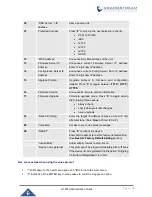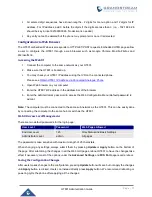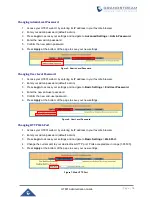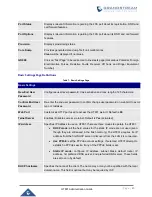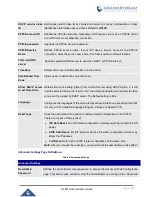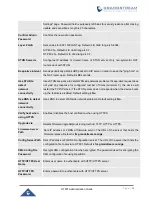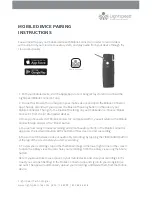
P a g e
|
20
HT801 Administration Guide
Port Status
Displays relevant information regarding the FXS port about its registration, DND and
call forward features.
Port Options
Displays relevant information regarding the FXS port about its DND and call forward
features.
Provision
Displays provisioning status.
Core Dump
Provides generated core dump file if unit malfunctions.
Clean
will be displayed if no issues.
GR909
Click on “Test Page” to be redirected to lines tests page (Hazardous Potential, Foreign
Electromotive Forces, Resistive Faults, Receiver Off hook and Ringer Equivalent
Number)
Basic Settings Page Definitions
Table 7: Basic Settings Page
Basic Settings
New End User
Password
Configures user level password. Case sensitive and max. length of 25 characters.
Confirm End User
Password
Re-enter the end user password to confirm change user password on web GUI to avoid
typo or mistakes.
Web Port
Customizes HTTP port used to access the HT801 web UI. Default is
80
.
Telnet Server
Enables / Disables access via telnet. Default is
Yes
(activated).
IP Address
Specifies IP Address to use on HT801.There are three modes to operate the HT801:
DHCP mode:
all the field values for the static IP mode are not used (even
though they are still saved in the flash memory.) The HT801 acquires its IP
address from the first DHCP server it discovers from the LAN it is connected.
Use PPPoE:
set the PPPoE account settings. If selected, HT801 attempt to
establish a PPPoE session if any of the PPPoE fields is set.
Static IP mode:
configure IP address, subnet Mask, default router IP
address, 1st preferred DNS server, 2nd preferred DNS server. These fields
are set to zero by default.
DHCP hostname
Specifies the name of the client. The name may or may not be qualified with the local
domain name. This field is optional but may be required by ISP.











